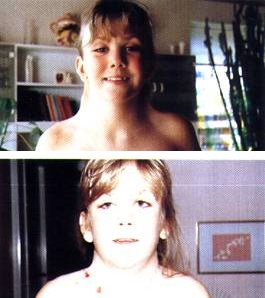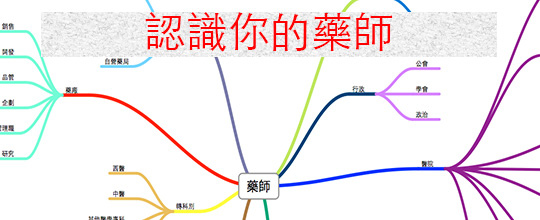你也可以直接上協會查:http://www.turnersyndrome.org/

Turner's Syndrome 特納氏症或是透那氏症,端粒綜合症,也稱為性腺發育不良或先天卵巢發育不良,是一種先天性的染色體異常疾病,是由性染色體全部或部分缺失引起的(正常人有46個染色體,其中2個是性染色體)。一般女性有2個X染色體,但Turner綜合征患者的性染色體缺失或有其他異常。在某些情況下,有些細胞中有缺失的染色體,而了一些沒有,這稱為嵌合體(mosaicism)。
簡單的說,就是一條或局部的「X染色體」缺乏,女性患者只有一條「X染色體」和染色體數目亦只有45條,它發生於二仟份一的女性,其成因是由母親的卵子或父親的精子變異而引致。正常人類的染色體為46,XX或是46,XY,若少了一條性染色體X或Y,形成45,X就是所謂的特納氏症。
在女孩中該疾病的患病率是1/2500。臨床病徵包括身材矮小、手腳淋巴水腫、寬胸闊乳、低髮際、頸蹼。 患病女孩通常出現性腺功能不全(卵巢無功能),從而導致閉經 (沒有月經)和不育。也經常出現隨之而的其他健康問題,包括先天性心臟病、甲狀腺功能低下症、糖尿病、視力問題、聽力問題和許多其他自身免疫性疾病。此外,還觀察到有患者存在視覺空間、數學和記憶方面困難等認知缺陷。
由來
1938 年由 Turner 醫師第一次描述,將身材矮小、幼稚型性徵(第二性徵不明顯)、蹼狀頸與肘外翻的婦女稱之為透納氏症(Turner syndrome)。到 1959 年,Ford 證實,透納氏症的病人缺少一條 X 染色體,因此其細胞核型為(45, X),百分之 99% 的(45, X)胚胎會流產,但若活產就會變成透納氏症。發生率約為每三千個活產女嬰有一個。一般透納氏症的發生為偶發事件,下一胎再發生的風險並不會增加。不過有少數的例外,包括遺傳性 X 染色體結構之變異,或者遺傳性的鑲嵌染色體(mosaicism)者。
除了典型的(45, X)透納氏症之外,也有所謂的變異型存在。這些變異型是具有性染色體構造異常,或者鑲嵌型的病人。這些變異型包括:
(45, X/ 46, XX)、(45, X/ 47, XXX)、(45, X/ 46, XX/47, XXX)鑲嵌型:這些病人的身高較高,透納氏症外型異常較不明顯,且可能具有生殖能力。
(46, X, i(Xq))、(45, X/ 46, X, i(Xq)):isochromosome Xq 約佔 15%,身材矮、性線發育不良及外型異常比(45, X)為輕,常出現自體免疫疾病。
(46, X, r(X))、(45, X/ 46, X, r(X)):ring X 的患者身材矮小,臨床表徵很輕微,三分之一有月經與第二性徵發育及智能不足。(典型則通常智力正常。)
(46, XXp-)、(45, X/ 46, XXp-):Xp-(proximal to Xp21):性腺發育不良,身材矮小。
(46, XXq-)、(45, X/ 46, XXq-):正常身高或矮小,性腺發育不良。
(45, X/ 46, XY)、(45, X/ 47, XXY):有不同的表型,包括女性、生殖器官混淆、男性皆有,容易罹患生殖母細胞瘤(gonadoblastomas)。在(45, X/ 46, XY)核型的患者,通常外觀表現為健康的男嬰,但不代表日後不會有問題,因此仍必須定期追蹤。
X-autosome translocation:Xq13-q26 為卵巢發育極重要之區域,若斷裂在 Xq13-q22 及 Xq22-q27 將造成性腺發育不良。
那些婦女需要做細胞染色體核型分析檢查?
(1) 不論年齡,不論有無出現其他的Turner’s綜合徵的表現,只要是身高排在(落在)同年齡的後十分之一或低於同年齡的標準線以下,則可做染色體核型分析檢查看看。
(2) 任何生育年齡婦女,以前沒有做過卵巢切除手術或卵巢電燒手術,如果檢測出腦下垂體促性腺賀爾蒙FSH(濾泡刺激賀爾蒙)偏高,尤其是身高少於155公分的女性則需要做細胞染色體分析檢查。
(3) 生育年齡婦女尤其是年齡小於35歲的婦女,如果以前沒有做過卵巢手術,但是陰道超音波檢查發現卵巢濾泡數偏少,可考慮做細胞染色體核型分析檢查。
(4) 本來應發生在男性的性聯遺傳疾病卻發生在女性,就要考慮這位女生染色體是否為45X,則需要做細胞染色體核型分析檢查來確定。
討論 :
在嵌合型(mosaic)Turner’s Syndrome(如45X / 46XX)的病人,其症狀比純形(pure 45,X)來得輕。一般說來,這些病人他們的智力、認知力及學習能力和常人無異。
n 這三位嵌合型病患都有不孕的問題。她們的卵巢功能較差,卵巢內的卵子較少,懷孕也比較容易流產。
n 如果病患45X細胞所佔的比例較高,出現Turner’s syndrome的徵候也越多,異常也越嚴重。例如:案例3,其身材也最矮(140公分),卵巢功能也最差。
n 對於純型Turner’s Syndrome(45,X)病人宜及早診斷及治療,對於嵌合型Turner’s Syndrome也不例外。例如:身高成長低於正常人,可及早投予Growth Hormone,有時可合併anabolic hormone(oxandrolone),例如案例\ 3的病人。有一文獻報告,在7-13歲平均治療5-7年,平均可增加身高7.2公分。
n Turner’s Syndrome患者如果到13~15歲還沒有出現第二性徵,可開始投予低劑量的雌激素,此劑量可慢慢增加。
n 這些病人的生育期(reproductive life)較短,對於已婚的患者,應鼓勵她們儘快懷孕並及早作介入性的治療,例如人工授精或試管嬰兒等。如果未婚,但年紀已到適婚年齡,可考慮卵子冷凍。如果真的沒有卵子,又想懷孕的話,可考慮利用他人捐贈卵子受孕。這些病人都會發生早發性停經。
Management of Turner's syndrome: gonadal dysgenesis; growth failure; skeletal dysgenesis
|
Characteristic |
Neonatal period or at diagnosis |
Childhood |
Adolescence |
Adulthood |
|
Gonadal dysgenesis |
Look for mosaicism. Look for Y-chromosome material if marker chromosome or virilization is present. |
Discuss reproductive options when appropriate |
Check follicle-stimulating hormone and luteinizing hormone before initiating hormone-replacement therapy around 12 years of age. Begin therapy with low doses of estradiol, and gradually increase during the next two to four years. |
Continue hormone replacement |
|
Growth failure |
Plot growth on growth curve specific for those with Turner's syndrome. |
Continue to monitor growth. Check thyroxine and thyrotropin levels. Check for obesity. Institute dietary counseling. Start growth horomone therapy with or without anabolic steroid when growth velocity declines. |
Stop growth hormone when bone age exceeds 15 yr or growth velocity drops below 2 cm/yr. |
Check thyroxine and thyrotropin levels. Check thyroid antibodies every 3 to 5 years. Continue dietary counseling. |
|
Skeletal dysgenesis |
Check for dislocated hips. |
Watch for scoliosis. Watch knee for tibial problems. |
Watch for scoliosis, lordosis, and kyphosis. |
Ensure adequate calcium intake (1.2 g/day). Encourage weight-bearing exercise. Check bone mineral density every 3 to 5 years. |
Management of Turner's syndrome: craniofacial malformation; abnormal carbohydrate metabolism; cardiovascular abnormalities
|
Characteristic |
Neonatal period or at diagnosis |
Childhood |
Adolescence |
Adulthood |
|
Craniofacial malformation |
Otitis and high arched palate are common. |
Otitis is common and should be treated
aggressively. |
Continue to monitor hearing. |
Continue to monitor hearing. |
|
Abnormal carbohydrate metabolism |
— |
Glucose-tolerance test may be abnormal. |
Glucose-tolerance test may be abnormal. |
Annual fasting glucose and lipid profile. |
Management of Turner's syndrome: genitourinary abnormalities; skin problems; central nervous system abnormalities; and other problems
|
Characteristic |
Neonatal period or at diagnosis |
Childhood |
Adolescence |
Adulthood |
|
Genitourinary abnormalities |
Perform renal ultrasonography to rule out structural anomalies. If present, screen yearly for urinary tract infection. |
Continue to monitor for urinary tract infection, if necessary. |
Continue to monitor for urinary tract infection, if necessary. |
Continue to monitor for urinary tract infection, if necessary. Perform urinalysis annually. |
|
Skin problems |
- |
Remove multiple nevi only if in area where rubbed by clothing. Warn patients to avoid unnecessary surgery because of keloid formation. |
Remove multiple nevi only if in area where rubbed by clothing. Warn patients to avoid unnecessary surgery because of keloid formation. |
Remove multiple nevi only if in area where rubbed by clothing. Warn patients to avoid unnecessary surgery because of keloid formation. |
|
Central nervous system abnormalities |
Refer to developmental intervention program if indicated. |
Screen for intellectual functioning, visuospatial organization. Attention deficit disorder may be more frequent. IQ is generally normal. |
Screen for intellectual functioning, visuospatial organization. Attention deficit disorder may be more frequent. IQ is generally normal. |
Screen for intellectual functioning, visuospatial organization. Attention deficit disorder may be more frequent. IQ is generally normal. |
|
Ophthalmologic abnormalities |
Perform ophthalmologic evaluation. |
Continue to monitor ophthalmologic examination. |
Continue to monitor ophthalmologic examination. |
Continue to monitor ophthalmologic examination. |
|
Other problems |
Perform stool guaiac test to check for gastrointestinal bleeding. Monitor for feeding problems. |
Perform stool guaiac test to check for gastrointestinal bleeding. |
Watch for anorexia nervosa and inflammatory bowel disease. |
Watch for anorexia nervosa and inflammatory bowel disease. Measure LFT, GGT annually. |
Ovarian hormone replacement treatment in TS
|
Age, yr |
Age-specific suggestions |
Comments |
|
10-11 |
Monitor for spontaneous puberty by Tanner staging and FSH level |
Low-dose estrogen treatment may not inhibit GH-enhanced growth in stature |
|
12-13 |
If no spontaneous development and FSH elevated, begin low dose E2 |
Equivalent initial E2 doses: depot (im) E2, 0.2-0.4 mg/month; transdermal E2, 6.25 µg daily*; micronized E2, 0.25 mg daily by mouth |
|
12.5-15 |
Gradually increase E2 dose over about 2 yr (eg, 14, 25, 37, 50, 75, 100, 200 µg daily via patch) to adult dose |
Usual adult daily dose is 100-200 µg transdermal E2, 2-4 mg micronized E2, 20 µg EE2, 1.25-2.5 mg CEE |
|
14-16 |
Begin cyclic progesterone treatment after 2 yr of estrogen or when breakthrough bleeding occurs |
Oral micronized progesterone best option at present; usual adult dose is 200 mg/d on d 20-30 of monthly cycle or d 100-120 of 3-month cycle |
|
14-30 |
Continue full doses at least until age 30 because normally estrogen levels are highest between age 15 and 30 yr |
Some women may prefer using oral or transdermal contraceptive for HRT; monitor endometrial thickness |
|
30-50 |
The lowest estrogen dose providing full protection vs. osteoporosis is 0.625 CEE or equivalent |
Monitor osteoporosis risk factors, diet, exercise; obtain BMD and begin regular screening mammography by age 45 yr |
|
>50 |
Decision on estrogen use based on same considerations as for other postmenopausal women |
New HRT options are appearing, and these recommendations may need updating in near future |
CEE: conjugated equine estrogens; E2: estradiol;
EE2: ethinyl estradiol; HRT: hormone replacement treatment.
* The lowest-dose commercially available E2 transdermal patches deliver 14 and
25 µg daily; it is not established whether various means of dose fractionation
(eg, administering a quarter patch overnight or daily or administering whole
patches for 7-10 d per month) are equivalent.
Reproduced with permission from: Bondy, CA; Turner Syndrome Study Group. Care of girls and women with Turner Syndrome: A guideline of the Turner Syndrome Study Group. J Clin Endocrinol Metab 2007; 92:8. Copyright © 2007 The Endocrine Society.
另外,只有在確診是特納氏綜合症,卵巢功能完全衰竭之情況下,服用雌激素(即動情激素)有助於長胸,即使您已36歲,雌激素應該還有機會讓胸部長大。





 留言列表
留言列表
 線上藥物查詢
線上藥物查詢 